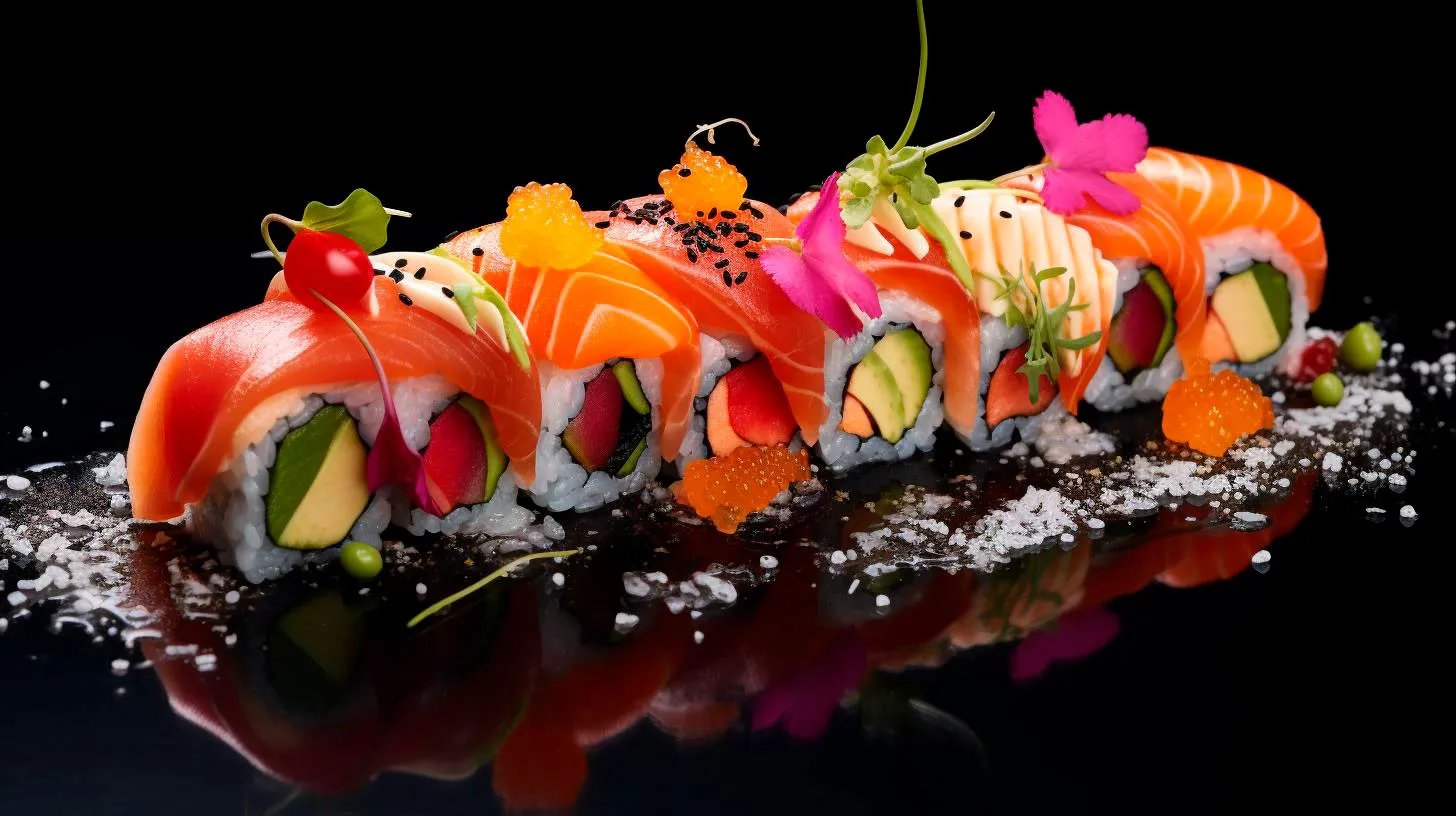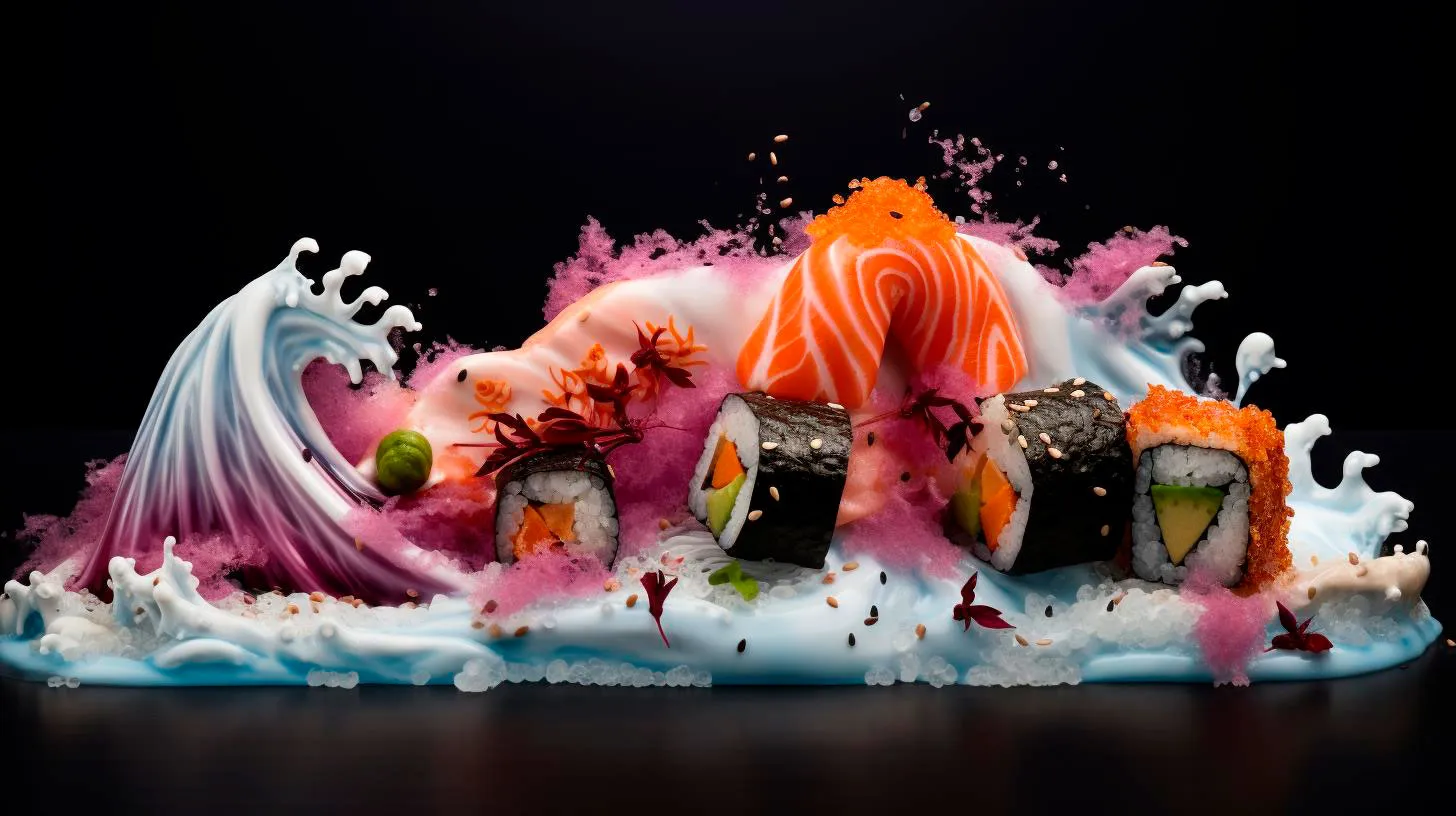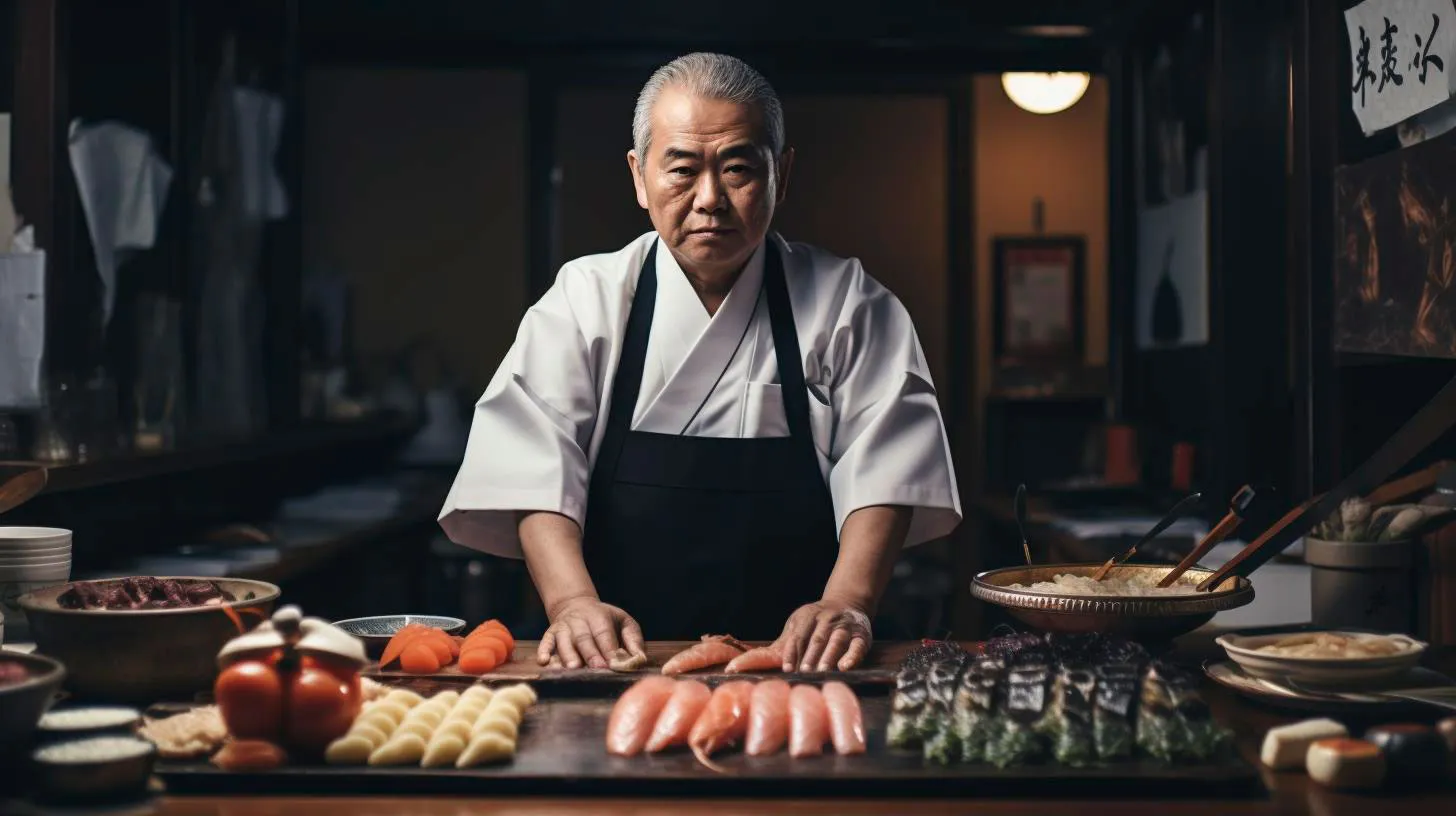Sushi Masterclass: Discover the Secrets of Traditional Japanese Roll Making
In this sushi masterclass, we will guide you through the step-by-step process of creating your own sushi masterpieces. Get ready to embark on a culinary adventure that will transport your taste buds to the heart of Japan.
The Art of Sushi Making
Sushi making is more than just assembling ingredients, it is an art form that requires precision and creativity. It originated in Japan and has since spread its influence worldwide. Traditional Japanese sushi is known for its simplicity, freshness, and precise technique. Understanding the core principles and techniques will help you elevate your sushi-making skills to the next level.
Why Learn to Make Sushi?
- Impress your guests with your culinary skills – Hosting a sushi night will undoubtedly make you the talk of the town. Your friends and family will be amazed by your ability to roll sushi like a pro.
- Explore your creativity – Sushi rolls offer a canvas for your creativity. Experiment with different ingredients, colors, and flavors to create unique and visually stunning rolls.
- Enhance your appreciation for Japanese cuisine – By learning the art of sushi making, you will gain a deeper understanding and appreciation for the intricacies of Japanese cuisine.
- Enjoy a healthy and balanced meal – Sushi is not only delicious, but it’s also a nutritious choice. It’s packed with lean proteins, healthy fats, and fresh vegetables.
Step-by-Step Guide to Sushi Making
Now that you understand the benefits of learning to make sushi, let’s dive into the step-by-step process. Keep in mind that the ingredients and techniques may vary depending on the type of sushi you are creating, but the core principles remain the same.
1. Prepare Your Ingredients
The key to delicious sushi is using fresh and high-quality ingredients. Here’s what you’ll need:
- Sushi rice
- Nori (seaweed sheets)
- Sashimi-grade fish or other proteins
- Vegetables (such as cucumber, avocado, and carrots)
- Soy sauce
- Wasabi and pickled ginger (optional)
2. Cook the Rice
The foundation of any great sushi roll is perfectly cooked rice. Rinse the rice under cold water until the water runs clear. Cook the rice according to the package instructions, and once cooked, let it cool to room temperature. Season the rice with a mixture of rice vinegar, sugar, and salt.
3. Prepare Your Workstation
Cleanliness is crucial when making sushi. Ensure that your hands, utensils, and work surface are clean. Place a bamboo sushi mat (called a makisu) on your work surface and cover it with plastic wrap to prevent the rice from sticking.
4. Roll Like a Pro
Place a sheet of nori on the prepared sushi mat. Wet your hands with water and take a handful of sushi rice. Spread the rice evenly over the nori, leaving a small border at the top. Add your choice of fillings, such as fish, vegetables, or a combination. Using the sushi mat, roll the nori tightly, applying gentle pressure to ensure a compact roll.
5. Slice and Serve
Once you’ve rolled your sushi, it’s time to slice and serve it. Use a sharp knife slightly wetted with water to prevent the rice from sticking. Slice the roll into bite-sized pieces and arrange them on a platter. Serve with soy sauce, wasabi, and pickled ginger.
Key Takeaways
By mastering the art of sushi making, you can add an impressive skill to your culinary repertoire. Here are the key takeaways from this sushi masterclass:
- Sushi making is a beautiful blend of artistry and technique.
- Learning to make sushi allows you to impress guests and unleash your creativity.
- Fresh and high-quality ingredients are crucial for delicious sushi rolls.
- Properly cooked and seasoned rice is the foundation of a great sushi roll.
- Cleanliness and precision are essential when handling sushi ingredients.
So, what are you waiting for? Dive into the world of sushi making and discover the secrets that have captivated taste buds for centuries. Not only will you create mouth-watering sushi rolls, but you’ll also gain a deeper appreciation for the art and culture of Japan.
Unveiling the Art of Making Sushi Techniques and Secrets
In this article, we delve into the fascinating world of sushi-making, exploring the methods, ingredients, and skills that make it a culinary masterpiece.
The Fundamentals of Sushi
Before diving into the intricate techniques, it’s essential to grasp the fundamental concepts that underpin sushi-making:
- Sushi Rice: The core of any sushi creation is the specially seasoned rice. It should possess the perfect balance of sweetness, acidity, and stickiness to complement the other ingredients.
- Sashimi: Sashimi refers to thinly sliced raw fish or seafood that often accompanies sushi. It showcases the freshness and quality of the ingredients, requiring precision when cutting.
- Nori: Nori is the seaweed wrapper used to encase sushi rolls. It adds a unique umami flavor and acts as a vehicle for the other ingredients.
- Wasabi and Soy Sauce: These condiments are integral to the sushi experience. Wasabi, often misunderstood as green-colored horseradish, adds a pleasantly spicy kick, while soy sauce enhances overall flavor when used in moderation.
The Techniques Behind Sushi-Making
Now that we have a basic understanding of sushi’s building blocks, let’s explore the techniques that bring it all together:
1. Slicing Fish Like a Master
The art of slicing raw fish requires precision, expertise, and a sharp knife. Key takeaways for this technique include:
- Using a long, thin blade to ensure clean cuts and minimal damage to the fish
- Slicing against the grain to create tender, melt-in-your-mouth textures
- Varying the cutting techniques according to the fish type, such as crisscrossing for certain white fishes
- Practicing consistency in slice thickness to maintain a balanced flavor
2. Rolling Perfect Sushi Rolls
Sushi rolls, also known as maki, showcase the creativity and artistry of sushi-making. Here are some techniques to master:
- Placing the nori shiny side down on the bamboo mat for even rolling
- Spreading an even layer of sushi rice on the nori, leaving a small border on one end
- Adding well-balanced fillings, such as fresh vegetables, sashimi, or tempura, to provide texture and flavor
- Using the bamboo mat to tightly roll the sushi, applying gentle pressure to avoid gaps
- Moistening the border with water to seal the roll and create a neat presentation
The Secrets of Sushi-Making
While the techniques are essential, understanding the secrets behind sushi-making elevates the craft to new heights:
1. Quality and Freshness
The quality of ingredients is paramount in sushi-making. Key takeaways to remember:
- Source the freshest fish and seafood from reputable suppliers
- Ensure the rice is cooked to perfection, using high-quality vinegar and precise measurements
- Prioritize seasonal ingredients to enhance flavors and support sustainability efforts
2. Balance and Harmony
Sushi is all about achieving a delicate balance of flavors and textures. Consider the following tips:
- Vary the colors and textures of your sushi creations to enhance visual appeal
- Ensure the soy sauce is used sparingly to maintain harmony between the ingredients
- Experiment with different combinations of sushi fillings to discover unique flavor profiles
3. Continuous Improvement
Mastering the art of sushi-making requires practice, dedication, and a commitment to continuous learning. Remember:
- Seek inspiration from renowned sushi chefs and their innovative techniques
- Experiment with new ingredients and flavors to push the boundaries of traditional sushi
- Attend workshops or classes to refine your skills and expand your knowledge
With these techniques and secrets, you can unlock the art of making sushi, creating restaurant-quality dishes in the comfort of your home. Embrace the intricate process, unleash your creativity, and savor the delightful flavors of this ancient Japanese culinary masterpiece.
Sushi Etiquette Do’s and Don’ts for Enjoying the Perfect Bite
So, whether you are a sushi aficionado or a newcomer eager to try this delectable dish, here are some essential do’s and don’ts to keep in mind for the perfect sushi experience.
Do’s
- Use chopsticks: When eating sushi, it is customary to use chopsticks for a more authentic experience. If you are not comfortable with chopsticks, you can politely ask for a fork, but it’s good to practice using chopsticks to fully appreciate the art of sushi.
- Hand cleanliness: Before touching any sushi, it’s crucial to clean your hands either by washing them with soap and water or using a wet wipe. This ensures that the sushi remains sanitary and avoids any cross-contamination.
- Condiments: Use condiments sparingly. Dip sushi lightly into soy sauce rather than soaking it entirely. The purpose of condiments like soy sauce, wasabi, and pickled ginger is to accentuate the natural flavors of the sushi, not overpower them.
- Ordering: If you’re dining at a sushi bar, you can ask the chef for recommendations or ask which sushi is the freshest. This allows you to get the most flavorful and high-quality sushi available.
- Eating order: Sushi should be eaten in one bite whenever possible. This allows you to experience the various flavors and textures fully. If the sushi is too large to eat in one bite, take small, elegant bites without leaving any half-eaten sushi on your plate.
Don’ts
- Separating ingredients: Avoid dissecting the sushi if it is served as a roll or nigiri. Each sushi piece is crafted with care, and the combination of ingredients is essential for a harmonious flavor profile. Eating the entire piece in one bite is the best way to appreciate the flavors as intended.
- No double-dipping: When using communal soy sauce, it’s considered impolite to double-dip. Once you’ve dipped your sushi, avoid re-dipping the same piece or using the same utensil to prevent mixing flavors and maintaining cleanliness.
- Wasabi placement: Mixing wasabi directly into the soy sauce is not the proper way to consume sushi. The sushi chef expertly places the right amount of wasabi between the fish and the rice. Trust the chef’s expertise and refrain from adding extra wasabi as it can overpower the balance of flavors in the sushi.
- Nibbling on pickled ginger: Pickled ginger, or gari, is served as a palate cleanser between sushi pieces. It is not meant to be eaten with sushi. Enjoy a small amount of ginger to cleanse your taste buds before moving on to the next sushi piece.
- Leaving rice behind: It is considered disrespectful to leave the rice behind when eating sushi. The balance of flavors relies on the combination of the rice, fish, and other ingredients. Finish your sushi in its entirety to pay homage to the chef’s craftsmanship.
Key Takeaways
Understanding sushi etiquette not only enhances your dining experience but also shows respect for the culture and tradition behind this beloved cuisine. Remember the following key takeaways:
- Use chopsticks when possible and keep your hands clean.
- Use condiments sparingly to enhance the flavors of the sushi.
- Ask for recommendations and order the freshest sushi available.
- Eat sushi in one bite and appreciate the various flavors and textures.
- Appreciate the chef’s craftsmanship and avoid altering the presentation of the sushi.
By following these do’s and don’ts, you’ll be able to fully immerse yourself in the art of sushi, not only savoring its flavors but also showing reverence for this cherished Japanese tradition.
The Many Types of Sushi: A Mini Guide
In this mini guide, we will explore the different types of sushi with their distinct characteristics, flavors, and fillings.
1. Nigiri
Nigiri is the most common type of sushi that comes to mind when we think of this delightful dish. It consists of a small ball of vinegared rice topped with a slice of fresh raw fish or seafood. Nigiri sushi allows you to savor the delicate flavors of the seafood with a hint of tangy rice.
- Key Takeaway: Nigiri sushi offers a simple yet elegant combination of flavors with the freshness of the fish taking center stage.
- Advantage: Its minimalist style allows you to appreciate the taste and texture of the fish without any overpowering fillings or sauces.
2. Maki
Maki is a type of sushi that consists of a layer of rice and various fillings rolled in a nori (seaweed) sheet. These rolls are then sliced into bite-sized pieces. Maki sushi comes in different varieties, including the popular California roll, which typically includes crab, avocado, and cucumber.
- Key Takeaway: Maki sushi offers a range of flavors and textures, thanks to the creative combinations of ingredients rolled inside.
- Advantage: The nori sheet provides a unique umami flavor, and the different fillings allow for endless customization.
3. Sashimi
Sashimi is a type of sushi that showcases the purest form of seafood. It consists of thin, bite-sized slices of raw fish or seafood, served without rice. Sashimi allows you to fully appreciate the taste, texture, and quality of the seafood.
- Key Takeaway: Sashimi emphasizes the natural flavors and textures of the seafood, offering a truly authentic experience.
- Advantage: It is a low-carb and gluten-free option, making it suitable for those following specific dietary preferences.
4. Temaki
Temaki refers to hand rolls that are made by wrapping a cone-shaped nori sheet around a filling of rice, seafood, and vegetables. These portable and easy-to-eat sushi rolls are perfect for an on-the-go snack or a casual dining experience.
- Key Takeaway: Temaki rolls provide a fun and interactive way to enjoy sushi, with each bite offering a burst of flavors.
- Advantage: Their unique shape and convenient size make them a popular choice for sushi lovers who prefer casual dining.
5. Chirashi
Chirashi, also known as scattered sushi, is a bowl of sushi rice topped with various sashimi or raw fish, vegetables, and other garnishes. This visually appealing dish presents a colorful assortment of ingredients, with each bite offering a harmonious blend of flavors.
- Key Takeaway: Chirashi provides a well-balanced meal in a bowl, with a variety of toppings that bring together different tastes and textures.
- Advantage: It offers a convenient option for those who prefer a sushi experience without the hassle of rolling or assembling.
Conclusion
Exploring the various types of sushi allows you to embark on a culinary adventure that caters to your unique preferences. From the simplicity of nigiri to the creative combinations of maki, sushi offers a wide range of options to satisfy every palate. Whether you opt for the traditional flavors of sashimi or the convenience of temaki rolls, sushi never fails to impress both in taste and presentation. So, the next time you visit a sushi restaurant, venture beyond your usual order and try out a new type of sushi to expand your culinary horizons!


